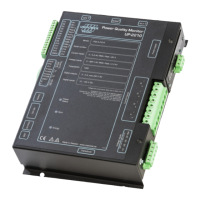events, for example when the door of a particular station is opened or closed, the temperature,
status, etc. The digital inputs are easily configured using the PQ Online program.
S0 interface. 1 opto isolated S0 output for energy pulses.
B. Time/TTL IRIG-B interface. Optional.
Temperature inputs. 2 Pt-100 sensor inputs. Optional.
RS-485 interface. Optional.
C. External display interface. A connection for graphical display unit, which can be supplied
as an option.
D. RS-232 interface, connection for communication for example with External modem.
E. RJ-45 connection for 10/100-BaseT Ethernet communication, which is available as an
option.
F. USB port. For on-site communication.
G. Connection for Power Supply. 85 – 264 V AC, 45-65 Hz / 100-365 V Dc, 10 VA. Power
supply is user replaceable. If a suitable DC voltage source is available this is a preferred
choice. If there is no station/internal battery backup, Unipower recommends that you connect
the instrument to an external UPS type battery source in order to prevent power failure
disturbances. The cable connected to the power supply unit of the UP-2210 unit must be 0,25
– 2,5 mm
2
(23 – 12 AWG) and fitted with a 2A fuse. Local installation regulation must
always be considered. For stranded cables we recommend fitting with a connector. If an AC
supply is used, the phase is connected to L input and the neutral conductor is connected to the
negative input, N on the UP-2210 meter. Always ensure that the UP-2210 unit is grounded
(earthed), using the input marked with the ground symbol.
H. UP-2210 meter has 4 differential current channels (the range is stated on the front label).
The current channels are designed for direct connection to the existing current transformer
(CT) secondary side. It is important to connect the current channels with the correct polarity;
otherwise the power charts displayed by the meter will be incorrect. Connect the current
channels in accordance with the wiring diagrams shown later in this manual. The current
inputs should be connected with 0,5 – 16 mm
2
(20 - 6 AWG) cable. Local installation
regulation must always be considered. For stranded cables we recommend fitting with a
connector.

